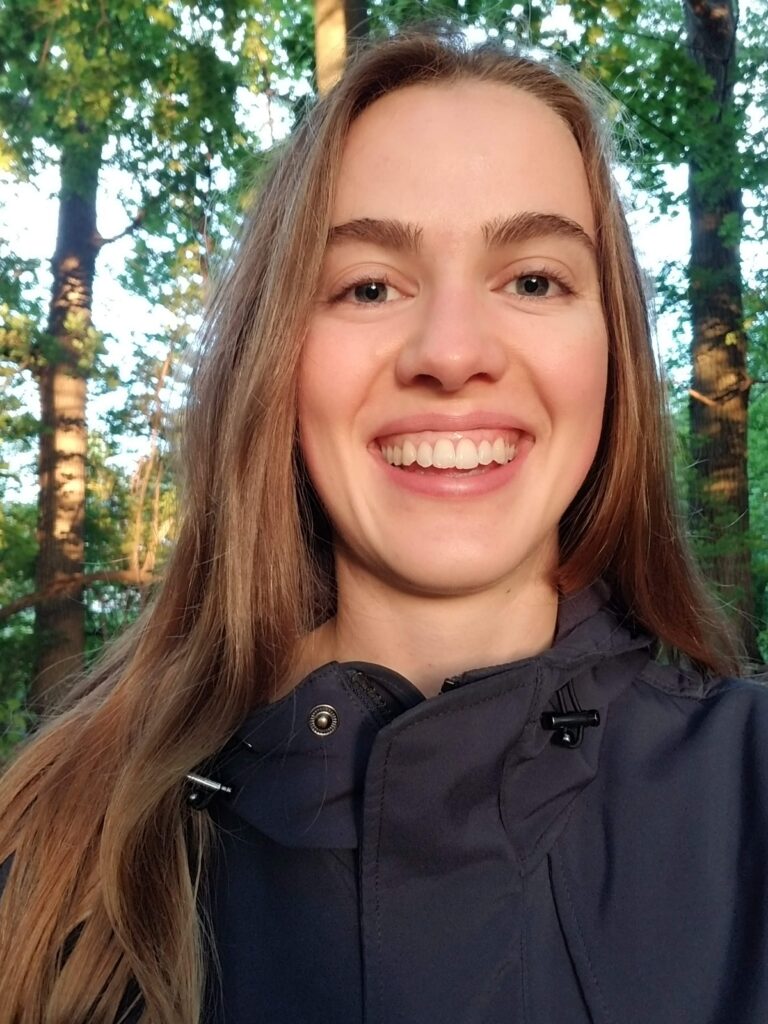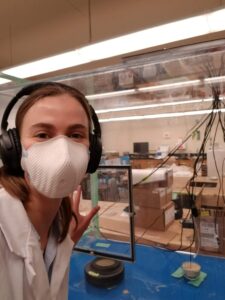
To mark the United Nations’ International Day of Women and Girls in Science on Friday, February 11 CivMin sat (virtually) with civil engineering MASc candidate Zoe Hoskin to discuss their experience exploring research options, impressions of attending U of T and living in Toronto.
Could you tell us a little about yourself, when you started in CivMin at U of T.
I started at U of T in September 2021. I’m originally from Toronto, first growing up in The Beach then in Brampton (about 40 minutes fromToronto). My undergrad was at McGill in Montreal. I’m researching indoor microbiomes, so different microbes in the built environment within buildings. Right now my topic is on studying SARS-CoV-2 RNA in indoor spaces. We’re using quantitative filter forensics to try to estimate how much SARS-CoV-2 RNA is in a given amount of air in indoor space, like a room within a house.

What attracted you specifically to U of T?
I really wanted to do research that had some significance for human health and/or environmental protection, and the building science research going on at U of T ties both together nicely. It’s a really fantastic opportunity to work with [co-supervisor] Professor Sarah Haines, given her expertise in the microbiology of built environments and also [co-supervisor] Professor Jeffrey Siegel with his expertise with quantitative filter forensics and beyond. I feel really lucky I have this opportunity to learn so much new stuff every week and improve my skills in a lot of different areas.
You’re originally from Toronto, moved away for your undergrad, then now moved back to Toronto, but much more centrally located. How do you like living downtown?
I like it. It’s a little bit different now, because of the pandemic, but it’s nice that it’s walkable. It’s nice being close to groceries, my friends to High Park and to campus. I can’t wait until concerts, comedy clubs, and queer events open up again–the kind of stuff that Toronto is known for.
You talked about your research area and supervisors Profs Haines and Siegel. They’ve covered a lot of ground on this topic during the pandemic, and continue to do so. Where will you be doing this research to assess these indoor environments?
We did a wave of experiments in homes of people who tested covid-positive, placing portable air cleaners in the rooms of people who were isolating, as well as in other places around the house. We then did RNA extractions and RT-qPCR on the dust on the filters of the portable air cleaners, and we finally did a filter forensics calculation to estimate the average number of copies of SARS-CoV-2 RNA present in each cubic metre of air in the room.
We’re hoping to expand this method to buildings with higher occupancies as restrictions open up.
This kind of research sounds like it would be a great benefit to the public at large. Is this sort of research being done anywhere else that you’re you know of?
Yes, Professor Siegel, and other researchers, have been doing filter forensics on other microbes and indoor air contaminants. This technique is important for schools, hospitals, social housing, and other shared indoors environments. Likewise, there’s wastewater analysis being done as a different means of environmental monitoring of the presence of SARS-CoV-2 RNA that gives data on the geographical scale of municipal areas rather than individual rooms/buildings. Professor Haines has also done research on environmental monitoring of SARS-CoV-2 using bulk dust collected from different locations/textiles within homes.

This reminds me of a now famous study from Hong Kong, known as a super-spreader event from SARS in 2003. It was a single infected person in a multi-unit building who wound up spreading the infection throughout to other not directly connected units. Could a comparison of this instance be made to your kind of research?
Yes, definitely, it’s really relevant for buildings that are attached and multi-unit buildings, especially social housing, because those types of buildings have more shared air between more occupants.
You’re still fairly new to U of T. but do you have any tips for other grad students coming into to the city, and U of T campus, for the first time?
I would say ask lots of questions at the beginning, because it’s normal to be really confused, especially in the first semester. There’s so much new stuff about being a grad student in general. In terms of Toronto, hopefully by this summer or fall there will be lots of different and interesting events, multicultural food festivals and concerts happening again.
Your ability, now during COVID protocol restrictions, to socialize with other grad students or other people is a bit restrained. You have to deliberately contact them, right? Is that what you’re finding?
Yes, I think it’s kind of like what our social life has become in general – keeping up with a few close friends, rather than meeting lots of people and hanging out in large groups.
How are you finding the workload right now, and how are you balancing?
This is my second semester and I think balancing my workload is it’s going a lot better this semester. I learned a lot through trial and error about time management during the first semester. I think it also helps to be really clear with your supervisor(s) about expectations, how long you should spend on certain tasks, research timelines, and grant application timelines. I think it’s really important to keep nurturing the other parts of your life, like friendships, hobbies, and other things that are important to you totally outside of school and work.
Do you do anything else outside of school for social life, entertainment or distraction – anything fun or unusual?
Outside of school, I like to do songwriting, play shinny, and hang out with my friends
By Phill Snel